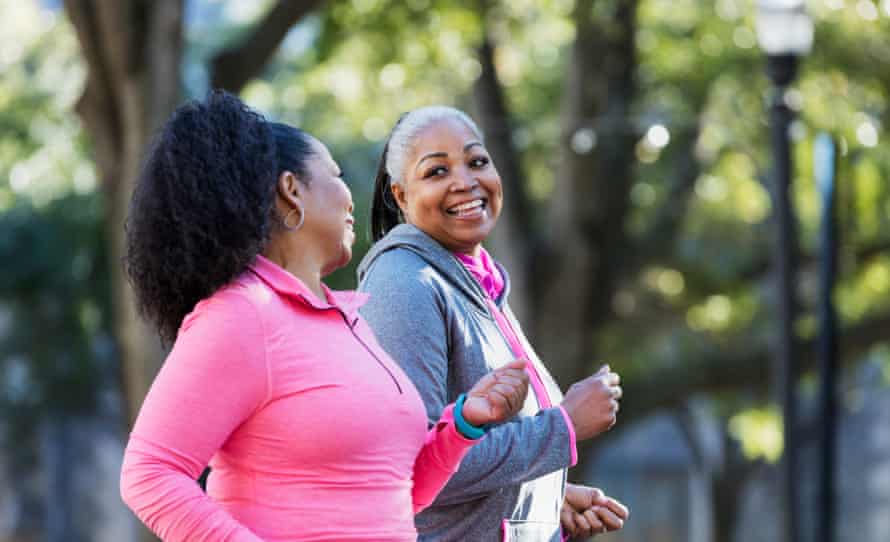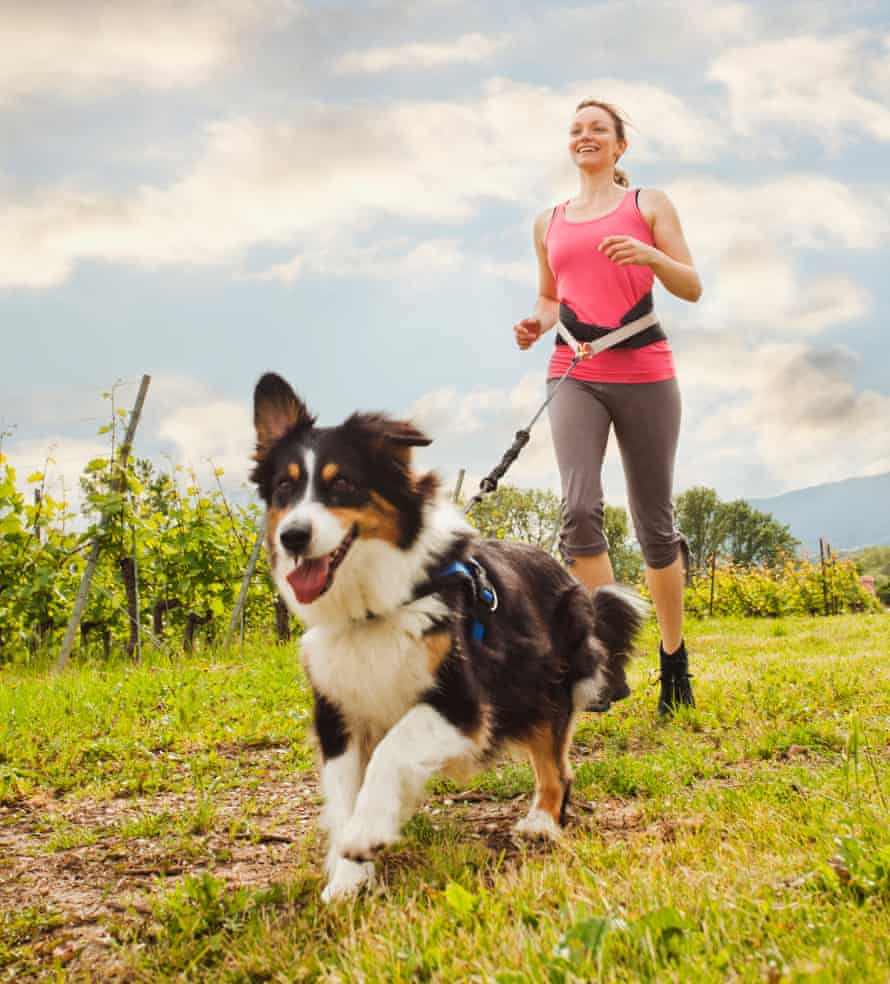Many people have been running more in lockdown – but your route may now be wearily familiar. Here’s how to get the excitement back

Over the past year – perhaps because of stress, boredom, and a need to get a break from video meetings and homeschooled children – an estimated 7 million people in the UK have been running. Sportswear stores have reported a leap in sales of running gear, and downloads of the popular Couch to 5K app almost doubled. For the able-bodied among us, running has become a new way of life. But now, after many months – and with distractions creeping in as lockdown restrictions lift – how can you ensure your running regime sticks? Here is some expert advice to keep you moving.
Change the route
You are probably running the same one or two routes from your door. “Run it in the opposite direction,” says Kerry Dixon, a personal trainer and co-founder of The Athlete Method. Even better, try out new routes. As an athlete, her running has mostly been on athletics tracks, so you could try that for novelty. If the thought of doing laps isn’t inspiring, start exploring. If you’re in a city, Dixon suggests setting yourself a challenge to run around all the parks. Now it’s allowed, plan a route further away from home. Before the pandemic, Andy Baddeley, who represented Great Britain in the 1500m in the 2008 Olympics and is CEO of the Running Channel, would drive, cycle or get the train to somewhere new and run a loop there (or run home). “Even if you cycle 5k away, you’re already in a completely different neighbourhood.”
Introduce intervals
Same route, different pace. “You might say: ‘I’m going to run for five minutes a little faster than my usual pace, then maybe walk or jog for two’, and then repeat that three or four times until you’ve run the distance that you want to,” says Dixon. “It changes the way your muscles are working, and creates a whole new workout, especially if you’re finding that you’re plateauing.”
Discover Fartlek training
For some people, interval training can feel a bit prescriptive. Fartlek is “a Swedish word that translates as speed play,” says Kerry McCarthy, commissioning editor at Runner’s World. “It basically means unstructured intervals.” Instead of working out an intervals plan and sticking to it, “with Fartlek you might go: ‘I’m going to leg it as fast as I can to that lamp-post, then I’m going to jog from there to the post office, and then go at medium pace to that tree.’ You kind of make it up as you go along.” It adds an element of playfulness, and keeps your mind engaged.
Set a goal
This could be anything from a time or distance you want to achieve, to signing up for a charity race or half-marathon (or more). “It’s quite fun to time yourself,” says Dixon. “It gives you something to work towards, a little competition with yourself without too much pressure.”

Get a training plan
When Dixon was competing, she found having a coach and a structured training plan was key – it kept her accountable, her goals in mind, and helped her see her progress. A personal trainer can be a good option, especially one who specialises in running, but there’s a wealth of free information online to create your own training plan, she says. “Then it’s about encouraging your friends and family to hold you accountable or asking them to be there when you need a moment of support.”
Join a club
There are clubs all over the country for every level (British Athletics is a good starting point, but Facebook can be useful in finding local groups). When Dixon was competing, being part of a club was vital, she says. “Being able to turn up to the track, have everybody wanting to work towards the same thing, you were able to push and encourage each other.” Some groups don’t even focus on running – you could join running sightseeing tours.
Or run with a friend
If you enjoy combining running with socialising – as opposed to using it to get away from other people – find a buddy. It “means you have to be ready to go out, otherwise you’re letting someone else down,” says Baddeley. You could do it virtually, he adds. “Agree that you’re going to run a certain distance or time at the same time of day with one of your friends, who might be in another country, and then check in with them afterwards. You don’t want to be the one saying: ‘I didn’t go.’”
Mix up the terrain
Not only is it better for you – “it requires your body to work in different ways,” says Dixon – it’s also more interesting to switch from tarmac to grass to woodland and fields. “You can get specialist shoes that will be more grippy when it’s muddy,” says Baddeley. “Just take extra care.”
Unplug for a mindful run
You’re used to running to music or have worked your way through every true-crime podcast ever made, so leave your device at home and embrace mindful running. “Mindfulness broadly is about being more present and more aware of what you’re doing, and not judging it,” says Baddeley. On a run, it’s “not thinking about how fast you’re running, or how far, but treating that time outdoors as meditation”. Focus on your breathing. “You can do 30 seconds of classic meditation before you actually go out the door, and then when you’re running, just constantly bring your mind back to your breathing. Your breathing might be quite ragged, but it gives you a focus.” It can be easy, especially on a familiar route, to switch off, which can be nice, says Baddeley, but consciously make an effort to notice things, “this particular kind of tree, a beautiful view, the sunset. Actually stop for a moment to appreciate that.”

Work on your running before you go
Jenny Blizard, a personal trainer and the founder of Blizard Run Club, says it will make your runs faster, easier and more enjoyable. Strengthen your achilles tendons by hopping, jumping or skipping, and work on your calf muscles with calf raises (go up on to the balls of your feet). Strength training will help you run faster, and improving your posture will help you run better. One of the best ways to work on posture is while walking, she says. “Feel each foot as it touches the ground, try to extend your leg out behind you more,” she says. Keep your shoulders back and your head forward “because so many runners look down to the floor, which makes them slump”. Practise deep-breathing exercises. Because many of us sit all day and don’t think about our breathing, “when you then go out for a run, you can’t breathe properly and find it so much harder work. Doing regular deep breathing increases the amount of oxygen that you can get, and running will be less work. It also improves your posture.” If you only do one thing, make it a dynamic warmup that could include squats and lunges. It will have an immediate effect, she says, raising blood flow and activating muscles – if you find you’re only just getting into your stride when you’re nearly home, this should create that feeling sooner. Since Blizard has been working on these exercises outside running, she has run her fastest races in 13 years. “Without actually doing any more running, you can be running faster.”
Change your mindset
“Connect with your values,” says Shameema Yousuf, a sports psychologist and founder of Empower2Perform. “Why do you go running? Is it because you want to stay healthy? If you’re going for a run with friends, is it because you like the connection?” She advises using positive self-talk to make a run more enjoyable. This could involve describing your legs as “power legs”. “When you’re out on a run, think about the next mile, or the next few hundred metres, and that breaks the run down so that it’s more manageable.” And don’t beat yourself up if, for a period, running feels like a slog or you didn’t manage to go as far as you would like. “Reframe it as: ‘I got out today and on my short run, I noticed …’” says Yousuf.
Make it useful
McCarthy is also co-founder of the #RunSome campaign, which aims to get people building running naturally into their day. For many of us, running is something we can do even if, at the beginning, it is only for a few seconds at a time. “Given that something like 23% of car journeys in the UK are less than a mile, if you’ve got to get a pint of milk or do the school run, any of those kind of day-to-day journeys, can you switch out some or all of that for running instead?” he says. “For people going back to offices, can you run-commute part of your journey?” A waist belt or running backpack can make popping to the shops or commuting easier. “It’s building it into the fabric of your life so that ‘going for a run’ doesn’t become another big item on your to-do list.”
Gamify your run
When Baddeley and his running friends set up a scavenger hunt, “it was the most fun I’ve had in the last year on a run,” he says. They ticked off items on the list, with different points for the hard-to-find ones (a llama, a celebrity), spotting horses, dogs and rabbits, and things including a body of water, a homemade den and a right-pointing signpost. It’s available as a printable download, but he says anyone could make up their own list with their running buddy or club. “It stopped me worrying about how fast or far I was running, or how I felt. And I felt like a child because I was quite excited when I found mushrooms or something.” There are other more hi-tech ways to add fun to your run – one of the best-known is the app Zombies, Run!, in which you are a survivor of a zombie apocalypse, combining storytelling (by the novelist Naomi Alderman) and missions.

Run with your dog
Combine two lockdown crazes – running and dogs – in one. The sport of canicross – off-road trail running, with your dog attached to you – has boomed in the past year. “You’ve got to walk your dog anyway, and if you’re going for a run, you might as well do it together,” says Ginetta George, founder of DogFit. “It’s amazing fun, and there are lots of social groups that meet up all around the UK and worldwide.” It can be good for rescue dogs who might be anxious, as they are attached to you, and is safer around livestock because your dog is never off-lead. It works for all breeds, she says, including smaller ones, and there are groups that cover very small distances as well as marathon-type ones, so it’s suitable for all levels. “You’re fitter, your dog is fitter,” she says. “You build a better bond with your dog. It’s a very social sport.” People also go it alone, she says. Don’t do it with a dog that’s less than a year old, and in summer, don’t run when it’s too hot (early in the morning or in the evening is best, and take lots of water). Getting a dog to help pull you along, wearing a specially designed harness, has to be the best and most fun way to increase your running time.





